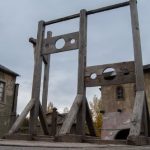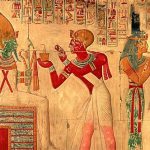 Our World
Our World  Our World
Our World  Pop Culture
Pop Culture 10 Incredible Female Comic Book Artists
 Crime
Crime 10 Terrifying Serial Killers from Centuries Ago
 Technology
Technology 10 Hilariously Over-Engineered Solutions to Simple Problems
 Miscellaneous
Miscellaneous 10 Ironic News Stories Straight out of an Alanis Morissette Song
 Politics
Politics 10 Lesser-Known Far-Right Groups of the 21st Century
 History
History Ten Revealing Facts about Daily Domestic Life in the Old West
 Weird Stuff
Weird Stuff 10 Everyday Products Surprisingly Made by Inmates
 Movies and TV
Movies and TV 10 Actors Dragged out of Retirement for One Key Role
 Creepy
Creepy 10 Lesser-Known Shapeshifter Legends from Around the World
 Our World
Our World 10 Science Facts That Will Change How You Look at the World
 Pop Culture
Pop Culture 10 Incredible Female Comic Book Artists
 Crime
Crime 10 Terrifying Serial Killers from Centuries Ago
Who's Behind Listverse?

Jamie Frater
Head Editor
Jamie founded Listverse due to an insatiable desire to share fascinating, obscure, and bizarre facts. He has been a guest speaker on numerous national radio and television stations and is a five time published author.
More About Us Technology
Technology 10 Hilariously Over-Engineered Solutions to Simple Problems
 Miscellaneous
Miscellaneous 10 Ironic News Stories Straight out of an Alanis Morissette Song
 Politics
Politics 10 Lesser-Known Far-Right Groups of the 21st Century
 History
History Ten Revealing Facts about Daily Domestic Life in the Old West
 Weird Stuff
Weird Stuff 10 Everyday Products Surprisingly Made by Inmates
 Movies and TV
Movies and TV 10 Actors Dragged out of Retirement for One Key Role
 Creepy
Creepy 10 Lesser-Known Shapeshifter Legends from Around the World
10 Fascinating Glimpses into Early Christianity
The Christian traditions of today have been forged by millennia of devotion, adaptation, worship, and strife. The roots of early Christianity are still visible, hidden in ancient or remote places. Some may be hidden in plain sight, such as beneath the streets of Rome. Other aspects have changed in surprising ways and are no longer recognizable.
The primary similarity between them all? They will remain forever fascinating. Plus, with Orthodox Easter 2024 falling on May 5th, now’s a great time to explore the intricacies and unique facets of early Christianity.
Related: 10 Connections Between Jesus, Christianity, and Ancient Egypt
10 Rome’s Hauntingly Beautiful Catacombs House Early Martyrs
Rome’s haunting catacombs offer sacred repose for some of Christianity’s first martyrs. These catacombs are among the earliest known Christian repositories and art galleries for some of the oldest discovered divine depictions.
Time-wise, some of Rome’s catacombs date back to the turn of the second century. They are “galleries dug into the bowels of the Earth,” offering a resting spot for those early believers persecuted and killed by the Roman emperors Decius, Valerianus, and Diocletian. In holy deference, pilgrims would come to pay their respects and decorate the walls with prayerful “graffiti.”
These images show some of the first evolutions of Christian art, such as Jesus being simply represented by a picture of a fish. Furthermore, these faithful worshippers would try to ensure their salvation by being buried as closely as possible to the catacomb martyrs.
The name for such necropolises, “cemetery,” came from the Greek “koimeterion,” meaning dormitory. After all, it’s said that the deceased Christians merely slept until the resurrection.[1]
9 Peter’s House in Capernaum
Jesus wandered much, through deserts and cities. But he also spent much of his life in the fishing village of Capernaum. The famed Capernaum sits on the north shore of the Sea of Galilee and potentially holds a fascinating piece of biblical archaeology: Peter’s house.
It was discovered under the remains of an octagonal Byzantine church that held the remains of martyrs. Peter’s possible dwelling dates back to the first century BC and is an ordinary Roman-period house with small rooms around two open courtyards. It was unsurprisingly humble, with coarse walls and an earth-and-straw roof. Yet, in the years following Jesus’ birth, it appears to have changed from a residence to a gathering hall, perhaps holding the earliest Christian gatherings.
Besides being made into a rudimentary church, it received a stone roof held up by two-story arches and a replastering with fancy flowers and geometric motifs. Inscriptions in Greek, Syriac, and Hebrew were scratched into its well, and it remained church-like for three centuries before being replaced with an official church circa the fifth century.[2]
8 The Star of Bethlehem (or Planets of Bethlehem?!)
The story of the wise men has it that they traveled far and hard to Jerusalem in search of Jesus’ birth. Instead, they met Herod. Worried about what it would mean for his earthly kingship, the big H sent the wise men, or magi, to search for the newborn.
Then, as per Matthew (2:9-10), ” Who having heard the king, went their way; and behold the star which they had seen in the east, went before them, until it came and stood over where the child was. And seeing the star they rejoiced with exceeding great joy.”
Could something really have lit up those skies? It was probably not an ephemeral meteor or supernova, which other cultures would have recorded. Instead, maybe it was a potential planetary conjunction, which happens when planets pass very close to each other in the sky.
Fortunately, astronomical software makes it easy to rewind the celestial clockwork, as it were. Accordingly, the years around Jesus’ birth would have seen more than one conjunction, including events in 7 BC and 3 BC. The latter was a brilliant conjunction of Jupiter and Venus, forming what could have appeared as a new star in the sky.[3]
7 An Alternate Jonah Story
Near the Sea of Galilee lies an ancient Jewish village called Huqoq, which has one of the most amazingly preserved artworks in an already history-rich region. Inside the ruins of a synagogue that is more than 1,500 years old, researchers found swathes of intact mosaics.
The mosaics show an alternate, slightly more humorous version of Jonah and the whale. In it, Jonah is swallowed by three successively large fish, potentially for the first time, kicking off an artistic trend to be echoed in diverse sources elsewhere.
The story goes that God asked the prophet Jonah to speak against the sinful city of Nineveh (in modern Iraq). Jonah refused and took off, boatwise, to open water. God responded by sending storms at Jonah, whose boat-mates blamed him for the curse and then threw him overboard to save themselves.
As if things couldn’t get worse, a succession of sea beasts then swallow Jonah. The mosaic is also notable for its aesthetic gamut, containing the building of the Tower of Babel and a group of Greek harpy sirens for good measure.[4]
6 A Word “Game” Reveals a Hidden Christian Message
The ancient SATOR (or ROTAS) squares are full of mystery and meaning, containing word games, mystique, and an early Christian Easter egg (not an actual egg). The squares have five words on top of each other: ROTAS, OPERA, TENET, AREPO, SATOR. These form an acrostic, an excellent word meaning that the letters are “mirrored left to right, up and down, and back to front.”
In the original order, there are multiple possible nuances, but one meaning could be: “Arepo the sower (sator) guides (tenet) the wheel (rotas) with skill (opera).” That’s somewhat biblical. Indeed, the medieval-era squares are related to Christianity.
But could the earliest squares also be Christian? They come from Pompeii circa AD 79, so they could be some of the earliest Christian relics. Here’s the potential proof: If you reconfigure the letters around the N at the center, you get two “pater noster” in the shape of a cross. The leftover A and O are the Greek alpha and omega: the beginning and end. Considering the Christians of the time had to hide their beliefs, this could have provided a secret way to worship.[5]
5 Wealthy Christians Commissioned a Sarcophagus
Art has always advanced beliefs, and early Christian artworks range from the simple to the how-did-they-do-that!? One exquisite example of the latter is the Santa Maria Antiqua Sarcophagus. This early Christian Roman sarcophagus was found under the floor of the Santa Maria Antiqua in Rome.
It’s made of white marble, dates to around AD 270, and was made for a wealthy Christian. The iconography is still nascent, showing the image of a “philosopher” and an “orant,” or a praying woman associated with a Greek or Roman muse.
In fact, much of the art draws from pagan sources, including a “Good Shepherd” based on ancient Greek art. And a reclining Jonah, after being spit out by the sea creature, inspired by Endymion, the eternal sleeper. The sarcophagus is unfinished, however, as can be seen by the blank faces on its facade.[6]
4 The Evolution of Churches
The first churches were simple house-churches, possibly no more than a small, hidden room within one’s private residence. These shrines were often decorated with wall paintings but were vastly more humble than the places of worship that succeeded them in later centuries.
Rome’s Santa Maria Antiqua Church represents an evolution in design and construction, showing how house-churches became something much grander. Like many Christian aspects, it was adapted from existing Roman features. The church was erected in the mid-6th century in a “monumental complex” dating to the reign of Domitian in the 1st century.
On its walls, a series of paintings from the 6th to 9th centuries show how motifs were influenced by Byzantine art. For example, an image of Our Lady holding the Christ-child mimics an enthroned Roman empress.
The church was demolished by an earthquake and abandoned in 847, then rediscovered in 1900. Like other churches worth their salt, it consecrates martyrs, including a chapel dedicated to the 40 Christian soldiers killed in AD 320 in Sebaste, Armenia, now Turkey.[7]
3 The Forty Martyrs of Sebaste
In AD 313, Emperor Constantine I and Emperor Licinius proclaimed the Edict of Milan, which put Christianity on equal footing with paganism. However, the two emperors were rivals, with Constantine ruling in the West and Licinius in the East, around Hungary.
Then, circa AD 320, Licinius mandated that Christian soldiers refuse their religion and offer sacrifices to pagan gods. But a cadre of 40 soldiers, part of the famed and awesomely named “Thundering Legion,” declined to supplicate these deities.
As a test of fate, the soldiers were placed on a frozen lake, naked and amid howling winds of the remote Sebaste region in (then) Armenia. A hot bath was established nearby to tempt them to leave Christianity and escape their frigid fate. A single soldier did flee for the bath but immediately died, leaving 39 martyrs.
Their number became 40 again very soon: One of the guards saw visions of angels crowning the soldiers and joined them to become a saved Christian himself. The soldiers did not renounce their Christianity, and most died on the lake after miraculously surviving for a few days. Any survivors were killed and burned, and their ashes were thrown into a river.[8]
2 The Earliest Known Church
If you could go back and stand in front of the earliest-known church, you wouldn’t even know it. Early churches, before Constantine made Christendom official, were hidden in houses.
Dura-Europos was founded circa 300 BC in modern Syria at the crossroads of empires. It was a cosmopolitan mix of Roman, Greek, and Persian, with diverse people, languages, and beliefs.
Ancient Dura-Europos is also essential as the site of the earliest-known church and among the earliest-known religious depictions, dating to AD 240. The church was a house-church, a room, shrine, or other relatively small gathering space where the faithful could worship or initiate converts. It also featured a baptistry, or place for converts, toward the front of the building.
It also features the earliest potential image of the Virgin Mary. The image shows her at a well, potentially representing the Annunciation, when Gabriel appears to her as she’s drawing water. Now-invisible details include a starburst around her abdomen, representing holy inception. Other images show Jesus walking on water and performing other miracles, including healing a bedridden man.[9]
1 The Apocalyptic Essenes
The Essenes were an apocalyptic, ascetic sect of Judaism that left Jerusalem and went out to live in the wilds. Their movement was a protest against the contemporary practices and ideologies at the Temple. In protest, the Essenes lived in a desert complex where they worshiped according to their own whims and wrote the famous Dead Sea Scrolls, according to scholars.
In the desert, the Essenes were free to follow the commands of the Lord, according to the prophet Isaiah, away from the worldliness of Jerusalem and its grand, golden-scaled Temple. They believed themselves the chosen ones and, according to an intriguing scroll, that a great apocalypse was nigh, righting society’s wrongs and establishing a newly righteous Temple.
They also believed that this “cataclysmic struggle” was between the Sons of Light (themselves) and the Sons of Darkness (everybody else). It would be a war of human forces as well as cosmic powers. The Essene beliefs have similarities to Jesus’ preachings in that a celestial shift was necessary to put things right and bring forth divine justice. Along with Jesus, the Essenes show a snapshot of the time, a roiling social landscape rife with upheavals and promises of coming salvation.[10]








